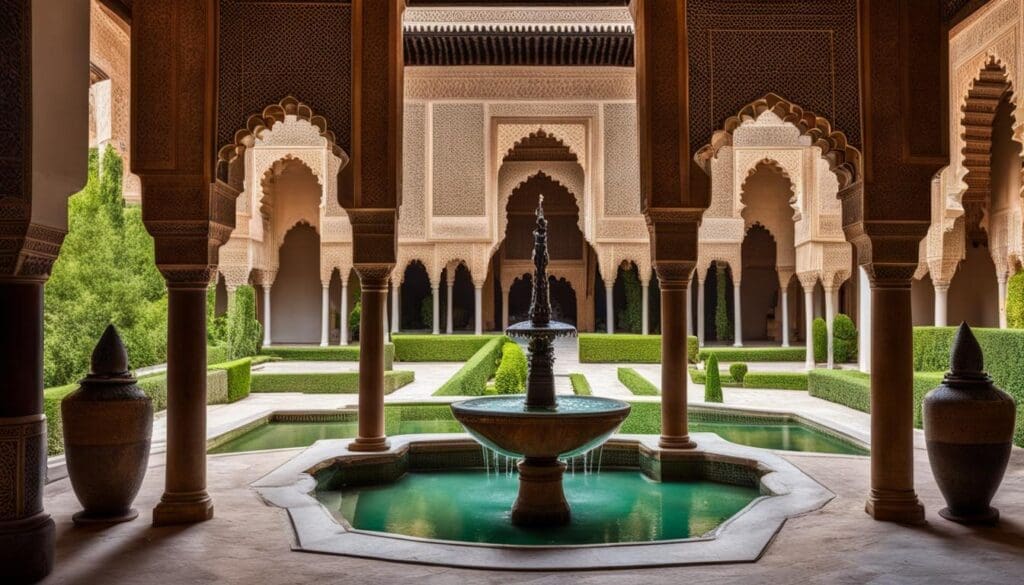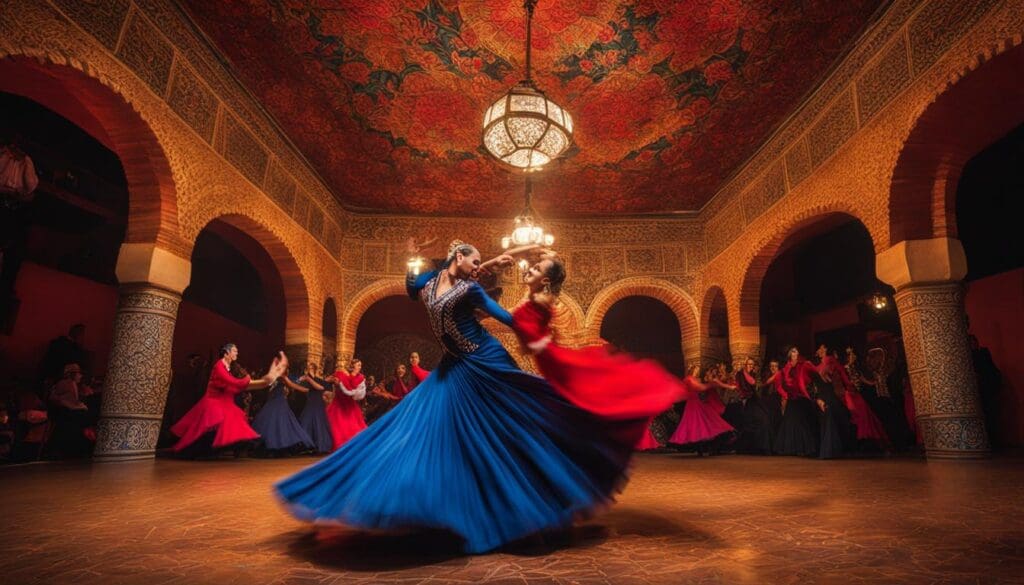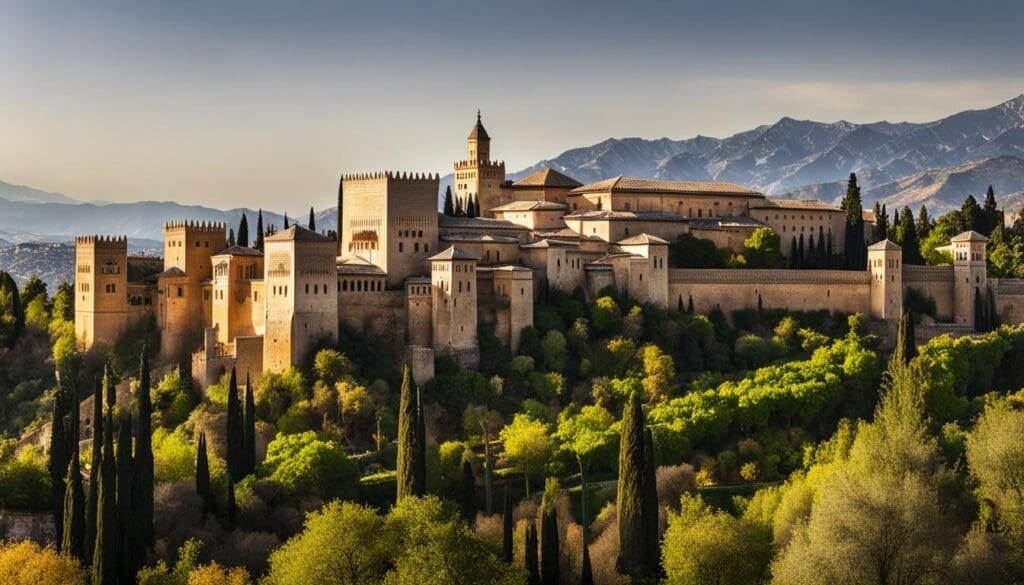Start your Spanish Immersion experience with Vamos Academy @ Malaga Spanish Language School, Buenos Aires, and Spanish Online. Immerse yourself in the vibrant traditions and fascinating past of Andalucía, a sprawling region in southern Spain renowned for its rich cultural heritage. From Flamenco and Bullfighting to Moorish architecture and culinary delights, Andalucía offers a captivating journey through time.
Key Takeaways
- Andalucía is known for its vibrant traditions, fascinating past, and rich cultural heritage.
- The region’s Moorish legacy is evident in its architectural marvels and cultural landmarks.
- Flamenco is deeply rooted in Andalucía’s culture and history, showcasing its vibrant cultural heritage.
- Bullfighting symbolizes Andalucía’s deep-rooted traditions and the triumph of man over nature.
- Andalucía’s ancient history includes influences from the Phoenicians, Romans, and Christian rule.
Embark on a journey to uncover the treasures of Andalucía’s past and immerse yourself in its rich history and culture.
The Influence of Moorish Legacy in Andalucía
Andalucía’s rich history is deeply intertwined with the legacy of Moorish rule. For over 800 years, North African Muslim tribes ruled over the region, leaving behind a lasting impact on its culture, architecture, and arts. Exploring Andalucía allows visitors to uncover the fascinating remnants of this historical era and witness the fusion of East and West that defines the region today.
One of the most remarkable examples of Moorish influence in Andalucía is the Alcázar in Seville. This architectural masterpiece showcases intricate Moorish design, featuring stunning courtyards adorned with lush gardens, fountains, and geometric patterns. As visitors wander through the Alcázar, they are transported back in time, gaining insights into the opulence and sophistication of Moorish civilization.
“The Moorish legacy in Andalucía is a testament to the region’s multicultural past and the enduring influence of Islamic culture on its architecture and arts.”
But the influence of Moorish legacy extends beyond the Alcázar. Throughout Andalucía, there are numerous historical sites and cultural landmarks that bear witness to this remarkable era. From the Great Mosque of Córdoba, with its distinctive horseshoe arches and exquisite tilework, to the Alhambra in Granada, a UNESCO World Heritage site renowned for its breathtaking Nasrid Palaces, every corner of Andalucía reveals the rich tapestry of Moorish architecture and design.
| Andalucía’s Moorish Legacy | Historical Sites |
|---|---|
| Alcázar of Seville | Alhambra, Granada |
| Great Mosque of Córdoba | Medina Azahara, Córdoba |
| Alcazaba of Málaga | Alhama de Granada |
| Roman Bridge, Almuñécar | Alpujarras, Sierra Nevada |
Uncovering Andalucía’s past is a journey that reveals the extraordinary influence of the Moorish legacy. From the architectural wonders to the cultural traditions that continue to thrive, the region’s heritage is a testament to the enduring power of Islamic culture in shaping its identity.


Flamenco and the Heart of Andalucía
Andalucía, with its vibrant cultural traditions, is renowned for being the birthplace of Flamenco. This passionate and expressive dance form has captivated audiences worldwide, but its roots run deep in the heart of Andalucía. The region’s cultural history is intertwined with Flamenco, making it an essential part of the Andalucían identity.
Experiencing Flamenco in Andalucía is an immersive journey into the soul of the region. The city of Seville, considered the epicenter of Flamenco, showcases the art form in its purest and most authentic state. The combination of mesmerizing footwork, soul-stirring music, and heartfelt vocals creates a powerful atmosphere that deeply resonates with both locals and visitors alike.
Furthermore, Flamenco is not limited to Seville alone; it is celebrated throughout Andalucía in small towns and villages. The annual flamenco festivals in these places bring together talented singers, skilled guitarists, and passionate dancers, showcasing the vibrant cultural heritage of the region. Attending these festivals is a unique opportunity to witness the harmonious synergy between the performers and immerse oneself in the rich tapestry of Andalucían culture.


The Beautiful Artistry of Flamenco
Flamenco is more than just a dance; it is a reflection of the deep emotions and history of Andalucía. The rhythmic footwork, intricate hand movements, and haunting melodies transport both performers and spectators to a different realm, where the heart and soul are laid bare. It is a reminder of the resilience and passion that resides within the Andalucían people.
Through Flamenco, visitors can gain a profound appreciation for the vibrant cultural history of Andalucía. The dance form is deeply rooted in the region’s traditions and serves as a powerful expression of the joy, sorrow, and resilience of its people. To witness Flamenco in Andalucía is to witness the embodiment of its cultural soul.
A Cultural Heritage to Treasure
Flamenco is just one facet of Andalucía’s vibrant cultural heritage. The region’s rich history, diverse traditions, and architectural wonders make it a treasure trove for those seeking to immerse themselves in the beauty of Southern Spain. From exploring the Moorish palaces of Alhambra to savoring the local cuisine, every aspect of Andalucía offers a glimpse into its cultural tapestry.
Whether you find yourself in the bustling streets of Seville or the serene white-washed villages of Ronda, Flamenco will always be at the heart of Andalucía. It is a living testament to the region’s unwavering passion and serves as a vibrant expression of its vibrant cultural history.
Bullfighting and its Symbolism in Andalucía
Andalucía is known for its deep-rooted cultural traditions, and one of the most iconic and controversial is bullfighting. Dating back centuries, bullfighting holds a significant place in the region’s history and serves as a symbol of the eternal dance between man and nature’s raw power.
Bullfighting is not just a spectacle; it is an art form that reflects the triumph of man over the mighty force of nature. The Plaza de Toros in Ronda stands as a testament to Andalucía’s bullfighting heritage. This historic site allows visitors to understand the cultural and historical significance of bullfighting in the region.
Experiencing a bullfight is an opportunity to witness the deeply ingrained traditions of Andalucía firsthand. The event encompasses more than just the matador’s bravado; it showcases the refined skills of the bullfighter, the intense emotions that permeate the crowd, and the momentary balance between life and death.


While bullfighting is a subject of controversy and criticism, it remains an integral part of Andalucía’s cultural fabric. Exploring the history and symbolism behind bullfighting allows visitors to gain a deeper understanding of Andalucía’s rich cultural heritage and the intricate traditions that have shaped the region.
Andalucía’s Roman and Phoenician Legacy
Andalucía, with its rich and complex history, boasts a fascinating Roman and Phoenician legacy that offers a glimpse into its ancient past. The region’s strategic location along the Mediterranean coast attracted the attention of these influential civilizations, leaving behind significant cultural and architectural landmarks.
Ancient Roman Sites
Andalucía is home to various well-preserved Roman sites that showcase the empire’s extensive influence. Cities like Cordoba and Seville were established as thriving Roman colonies, featuring grand structures and paved roads that provided essential infrastructure for commerce and governance. The Roman Theater in Málaga is another notable site, offering a glimpse into the ancient entertainment that took place in the region.
Phoenician Legacy
The Phoenicians, a seafaring civilization known for their trade and maritime prowess, also left a lasting impact on Andalucía. The city of Cádiz, founded by the Phoenicians around 1100 BC, still exhibits traces of its ancient Phoenician roots. Its strategic location as a port city attracted traders from across the Mediterranean, contributing to its growth and cultural diversity.
| Ancient Roman Sites | Phoenician Legacy |
|---|---|
| Cordoba | Cádiz |
| Seville | |
| Málaga |
Exploring these Roman and Phoenician sites allows visitors to delve into Andalucía’s ancient history and gain a deeper understanding of the region’s cultural evolution. The archaeological remnants and historical artifacts transport travelers back in time, unraveling the stories of these powerful civilizations and their impact on Andalucía’s present-day identity.
Next, we will dive into the significant impact of the Reconquista and Christian rule on Andalucía’s historical narrative.
The Impact of the Reconquista and Christian Rule
Andalucía’s history took a significant turn with the arrival of Christian rule during the period known as the Reconquista. This military conquest marked the end of Muslim rule in the region and had a profound impact on Andalucía’s cultural heritage. The Christian reconquest reached Andalucía in the 13th century, leading to the capture of cities like Cordoba and Seville.
Under Christian rule, Andalucía witnessed a reshaping of its architectural landscape and cultural traditions. Gothic cathedrals and churches were built, replacing the once prominent Moorish mosques. The imposing Cathedral of Seville stands as a testament to this era, blending Christian and Moorish influences in its design.
H3: Christian Architecture and Andalucía’s Rich Cultural Heritage
“The blending of architectural styles during the Christian rule showcases the rich cultural heritage of Andalucía. The Moorish influence, fused with the new Christian aesthetics, brought about a unique architectural language that can still be seen today.”
Exploring the sites associated with Christian rule provides a deeper understanding of Andalucía’s historical journey. The grandeur of the Alhambra in Granada, originally built as a fortress by the Moors, was transformed into a royal palace by Christian monarchs. This transformation reflects the region’s complex and intertwined history.
| Christian Rule in Andalucía | Key Sites |
|---|---|
| 13th century onwards |
|
As Andalucía transitioned from Muslim to Christian rule, its cultural heritage evolved, leaving behind a remarkable legacy that continues to shape the region’s identity. Exploring these historical sites allows visitors to appreciate the intricate interplay of cultures and the enduring impact of the Reconquista on Andalucía’s rich history.


Andalucía’s Jewish Heritage
Andalucía boasts a rich Jewish heritage that spans centuries, intertwining with the region’s vibrant multicultural history. For centuries, Jews coexisted with Moors and Christians, contributing to the diverse fabric of Andalucía’s cultural tapestry. Sephardic Jews, in particular, played a significant role in shaping the region’s economic, intellectual, and artistic landscape. Their influence can still be felt today, offering a unique perspective on Andalucía’s rich past.
Exploring the Jewish history of Andalucía is a captivating journey that unveils the profound impact of the Jewish community on the region’s development. The Sephardic Jews, who were expelled from Spain in 1492, left behind a legacy of contributions in fields such as banking, medicine, law, and commerce. The Jewish Quarter in Cordoba, with its narrow winding streets and the iconic Cordoba Synagogue, offers a glimpse into the vibrant Jewish life that once thrived in the region.
“Andalucía has a rich Jewish heritage that dates back centuries.”
The Jewish history in Andalucía serves as a testament to the region’s cultural tolerance and the significant role played by its Jewish community. Exploring the synagogues, museums, and historical sites dedicated to Jewish heritage allows visitors to better understand the multicultural past of Andalucía and the lasting contributions of its Jewish inhabitants.
| Historical Site | Location | Description |
|---|---|---|
| Aljama Synagogue | Cordoba | One of the best-preserved medieval synagogues in Spain, showcasing stunning Mudéjar architecture. |
| Sephardic Museum | Toledo | Houses an extensive collection of artifacts and documents that highlight the Sephardic Jewish heritage. |
| Jewish Quarter | Malaga | Home to the remains of the ancient Malaga Synagogue, offering insights into the Jewish history of the city. |
Exploring these historical sites not only provides a deeper understanding of Andalucía’s multicultural past but also pays tribute to the diverse communities that have shaped the region. It is a reminder of the importance of preserving and celebrating the cultural heritage of Andalucía’s Jewish community.


The significance of Jewish heritage in Andalucía
Jewish heritage holds immense significance in Andalucía as it represents the region’s commitment to religious and cultural diversity. The memory of the Jewish community is celebrated through festivals, exhibits, and dedicated cultural centers. By delving into this rich history, visitors can gain a profound appreciation for the multicultural tapestry that makes Andalucía truly unique.
Andalucía in the Modern Era
Andalucía, with its vibrant cultural history and numerous historical sites, has experienced significant changes in the modern era. The region’s ports, such as Cadiz and Seville, were once bustling centers of trade, playing a crucial role in the flow of wealth from the New World in the 16th and 17th centuries. However, the loss of colonies, economic decline, and political instability had long-lasting effects on Andalucía’s development.
Despite these challenges, Andalucía has managed to preserve its rich cultural heritage and attract tourists from around the world. From the Moorish influences seen in the architecture of the Alhambra to the lively Flamenco performances in Seville, the region continues to captivate visitors with its unique traditions and vibrant cultural landmarks.
Today, Andalucía is a dynamic mix of the old and the new. Its historic cities still embrace their historical past, while also embracing modernity and progress. The region boasts modern infrastructure, vibrant nightlife, and a thriving arts scene. Visitors can explore contemporary museums and galleries, dine in award-winning restaurants, and enjoy a vibrant music and theater scene.
Modern Era Highlights in Andalucía
- The transformation of Seville from an industrial center to a vibrant cultural hub.
- The revitalization of historic neighborhoods, such as Malaga’s Soho district, into creative and artistic spaces.
- The development of world-class golf courses and luxury resorts along the Costa del Sol.
- The emergence of innovative wineries and vineyards in the region, producing award-winning wines.
With its combination of historical charm and modern amenities, Andalucía offers a compelling destination for travelers looking to immerse themselves in a rich cultural experience. Exploring the region’s modern era allows visitors to understand the resilience and evolution of Andalucía’s vibrant past.


| Modern Era Highlights | Description |
|---|---|
| The transformation of Seville | Seville has blossomed into a vibrant cultural hub, attracting artists, musicians, and creatives from around the world. |
| Revitalization of historic neighborhoods | Historic neighborhoods like Malaga’s Soho district have been transformed into vibrant spaces for art, culture, and creativity. |
| Development of golf courses and luxury resorts | The Costa del Sol has become a popular destination for golf enthusiasts and luxury travelers, offering beautiful courses and high-end accommodations. |
| Innovative wineries and vineyards | Andalucía’s wine industry has experienced a renaissance, with innovative wineries producing exceptional wines that are gaining recognition on the world stage. |
Conclusion
Embark on an unforgettable journey to discover the rich history and culture of Andalucía, a region in southern Spain that captivates with its vibrant traditions and fascinating past. From Moorish influences to mesmerizing Flamenco performances, Andalucía’s cultural heritage offers a truly enriching experience for every traveler.
Andalucía’s historical sites, such as the Alcázar in Seville and Ronda’s Plaza de Toros, provide glimpses into the deep-rooted traditions of this region. Uncover the ancient history and cultural landmarks that showcase the fusion of Gypsy, Jewish, Moorish, and Christian cultures in Andalucía.
Immerse yourself in the vibrant heart of Andalucía, where Seville is famous for being the epicenter of Flamenco, a passionate dance form that has captured hearts around the world. Experience firsthand the harmonious synergy between singers, guitarists, and dancers, and revel in the vibrant cultural heritage of this region.
Delve into the symbolism of bullfighting, a tradition that goes beyond a mere spectacle and reflects man’s triumph over nature’s raw power. Visit Ronda’s Plaza de Toros to understand the significance of bullfighting in Andalucía and appreciate the region’s deep-rooted traditions.
Explore Andalucía’s Roman and Phoenician legacy, where cities like Cordoba and Seville bear witness to the rich and organized colony established by the Romans. Discover the region’s multicultural past by exploring its Jewish heritage, which coexisted with Moors and Christians throughout history.
Andalucía’s journey continues into the modern era, with periods of economic prosperity and decline leaving a lasting impact. But amidst it all, the treasures of the past remain, waiting to be uncovered by the curious traveler.
With its ancient historical sites, unique traditions, and vibrant cultural landmarks, Andalucía invites you to immerse yourself in its rich history and culture. Discover the wonders of this southern Spanish region and let it captivate your senses as you uncover its fascinating past.
FAQ
What are some of the cultural highlights of Andalucía?
Andalucía is known for its vibrant traditions, including Flamenco, Bullfighting, and a unique blend of Moorish architecture and arts. The region also offers a diverse culinary scene, with notable wines, olives, olive oil, Iberico ham, and cured pork delights.
What are some of the historic cities to visit in Andalucía?
Some of the historic cities in Andalucía include Seville, Malaga, Córdoba, and Granada. These cities showcase preserved history and traditions, offering visitors a glimpse into the region’s cultural heritage.
What is the significance of Flamenco in Andalucía?
Flamenco is a passionate dance form that originated in Andalucía and has become a symbol of the region’s cultural heritage. Seville, in particular, is known as the epicenter of Flamenco, and visitors can experience the harmonious synergy between singers, guitarists, and dancers during the annual flamenco festival.
What does bullfighting symbolize in Andalucía?
Bullfighting in Andalucía symbolizes the eternal dance of death and rebirth, reflecting man’s triumph over nature’s raw might. Ronda’s Plaza de Toros is a historic site that offers insights into the heritage of bullfighting in Andalucía.
What is the Roman and Phoenician legacy in Andalucía?
Andalucía has a rich ancient history that dates back to the Roman and Phoenician civilizations. The Romans established cities like Cordoba and Seville, leaving behind paved roads and other architectural marvels. Exploring the Roman and Phoenician heritage allows visitors to uncover the region’s ancient past.
How did the Reconquista and Christian rule impact Andalucía?
The Reconquista, a period of Christian military conquest, played a significant role in Andalucía’s history. The Christian reconquest reached Andalucía in the 13th century, leading to the capture of cities like Cordoba and Seville. The influence of Christian rule can still be seen in Andalucía’s architecture and cultural heritage.
What is the Jewish heritage in Andalucía?
Andalucía has a rich Jewish heritage that dates back centuries. Jews coexisted with Moors and Christians, contributing to the region’s cultural diversity. Exploring the Jewish history in Andalucía offers insights into the region’s multicultural past and the contributions of its Jewish community.
How has Andalucía evolved in the modern era?
Andalucía has experienced periods of economic prosperity and decline in the modern era. The region’s ports of Cadiz and Seville played a crucial role in the flow of wealth from the New World in the 16th and 17th centuries. Exploring the modern era in Andalucía allows visitors to understand the region’s journey through time.
What can I expect when discovering the rich history and culture of Andalucía?
Embarking on a journey to discover the rich history and culture of Andalucía allows visitors to immerse themselves in vibrant traditions and a fascinating past. From exploring ancient historical sites to witnessing Flamenco performances, Andalucía offers a truly enriching experience for every traveler seeking to uncover the treasures of the past.




